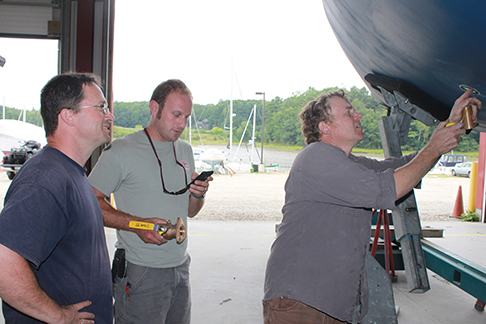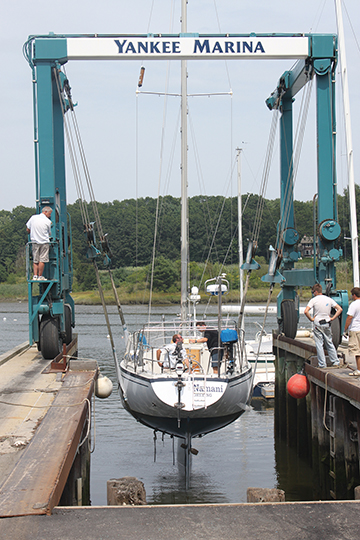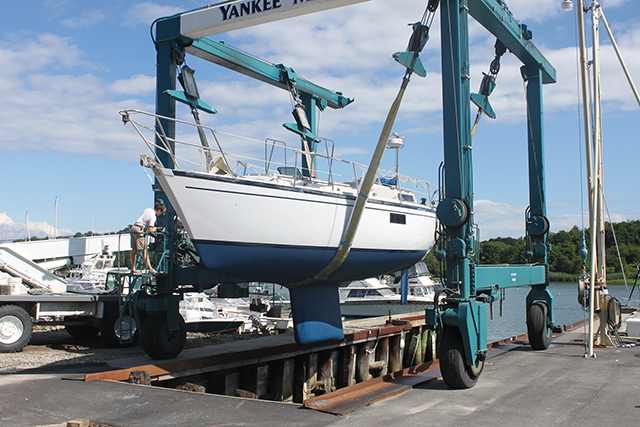Getting the most out of every type of boat evaluation (published December 2012)
If only we knew then what we know now! In five years of owning our current boat, a 1981 Dufour 35, we’ve had three professional surveys of vastly differing qualities. Comparing our experiences taught us how to get the most from a survey, as did discussions with a seasoned professional, Tony Theriault of Theriault Marine Consulting in Cape Elizabeth, Maine. Our conclusions? First, we learned the importance of setting clear expectations, as well as understanding the owner’s role before and during a survey. We also discovered that surveys are not just for sailors interested in buying a boat or renewing insurance. Surveys can also be excellent evaluative tools to identify any weaknesses to address before heading out for another season—or around the world.
 FINDING A SURVEYOR
FINDING A SURVEYOR
Whether you are interested in a pre-purchase survey, an insurance renewal, a consultative survey, damage assessment or a value appraisal, you must first locate a credentialed surveyor. In the United States, the accrediting agency is the National Association of Marine Surveyors, which requires that members show adequate experience and pass an extensive test. Look for a surveyor who is past the associate status and on to full certification. Next, check where your surveyor’s experience lies. Some specialize in wood, aluminum or steel hulls, or even in tall rigs. The right surveyor will carry the tools needed for the job at hand and have experience in the appropriate area.
Equally important is talking with the surveyor to see if you are compatible. As Tony Theriault points out, it’s a job that calls for good communication and people skills. A good surveyor is a person you can trust to help make important decisions, and who can bridge the potential divide between a buyer and a seller (in a pre-purchase survey, the buyer hires the surveyor).
Once you have found a surveyor, make sure you clearly specify and agree on the scope of the survey—the more detail, the better. In a pre-purchase survey, will the surveyor go aloft to look at standing rigging? To what extent will the electrical system be examined? Be sure to describe your level of experience so that the surveyor knows whether to assume you have a high familiarity with boat systems or not.
Explain what exactly you want to achieve in the survey so that the outcome will match your expectations. A consultative survey, for example, may be requested by an owner who suspects trouble in a particular area, or it might extend to a full survey that will guide an upcoming re-fit. Then the surveyor can provide a realistic time and price quote and you can both plan accordingly.
PREPARING FOR THE SURVEY
In our very first, pre-purchase survey, we failed to properly prepare the boat. As a result, the surveyor only took a perfunctory look beneath settees and into cluttered lockers. He failed to get to the bottom of things—literally—and didn’t examine some of the vessel’s fundamental support structures. At the time, we didn’t know enough to insist on more, or to recognize that we had failed to provide the structure for a thorough survey.
In contrast, Tony Theriault spent hours on our second, consultative survey in which we sought to identify areas to address in re-fitting the same boat. Watching him move masses of gear and maneuver into the most uncomfortable reaches of the boat made us appreciate the work of a true professional dedicated to our cause. In the end, we had a truly thorough and candid look at the health of our boat. However, this was only accomplished at the expense of valuable time (in fact, it required a second visit to complete the job).
Lesson learned: prepare the vessel in order to permit a thorough examination. Don’t waste the surveyor’s valuable time—and your money! Empty every locker, shelf and cubbyhole. Buy extra-large, inexpensive containers to store surplus equipment and get as much as possible out of the way. This will allow the surveyor to immediately focus on critical systems. Key areas to provide access to are the chain plates, hull-deck joint, and high stress areas around bulkheads and the compression post. It’s equally important to expose the steering system, engine transmission shaft, batteries and central electrical areas.
Ideally, try to find a time slot not followed by any pressing engagements for you or the surveyor. That will allow the surveyor to attend to all areas without rushing and to run overtime if necessary. A full, pre-purchase survey on a used 35-foot sailboat should take the bigger part of a day (or two half days), so if the potential surveyor quotes you an hour, look elsewhere. On the other hand, a consultative survey limited to a specific area of concern may take only a few hours.
It is absolutely critical that you, the owner, are present for the survey. Ask questions, listen and take notes. Learn from the surveyor and draw his attention to your areas of concern. Let him know what type of sailing you plan to do and in what conditions. If you race, tell him; if you heard a creaking sound last season, make sure he knows. As a boat owner, you must act as the voice of your vessel in the same way that a parent reports on the health of a young child to a pediatrician.
 DURING A SURVEY
DURING A SURVEY
A full survey will have three parts. First, the vessel should be examined out of the water to inspect the hull, keel, rudder and propeller. The second section is a dockside component, inspecting the deck, internal structure and all systems while the boat is afloat. The final part is a sea trial to check the rigging, sails and engine at work.
Normally, a surveyor will avoid destructive testing, taking readings with a moisture meter and tapping the hull with a rudder-tipped hammer. An experienced inspector will notice a spongy feeling on deck and pick up subtle differences between the hammer’s pings. If the surveyor suspects damage or weakness, he might recommend exposing a section of fiberglass or taking a core. It’s possible that key areas on some hulls are impossible to access without destructive measures (on our sloop, for example, the keel bolts are glassed over). This means an owner must decide whether to leave well enough alone or to go all the way by opening up these areas. This decision can be based on the boat’s age, history and any evidence of possible damage.
There are two specialty areas that many surveyors do not cover in detail: most will not go aloft to inspect standing rigging, nor are they qualified mechanics who can make more than a general engine inspection. Buyers interested in older vessels should consider bringing in a specialist rigger and mechanic. The fees do add up, but it can be a worthwhile investment considering the costs of rigging or engine failure (not to mention the potential for endangering the crew).
A true professional is like a teacher and safety coach in one, making sure you have the best boat for your purpose and budget. A boat that is not suitable for one sailor may be perfect for another, and the surveyor will act as a matchmaker between boat and sailor in a pre-purchase survey. For owners who already know their boats well, a surveyor can bring the tools and fresh perspective needed to find any weaknesses lurking beneath the surface.
THE SURVEY REPORT
The surveyor will summarize his or her findings in a multi-page report in both paper and digital format, complete with photos. Be cognizant that the report takes time to write up—an important consideration if you are trying to squeeze the survey, launch date and new insurance coverage into a short period of time. It can be useful to compare old surveys to a more recent version, so hold onto all the material you have. Some insurance companies will grant coverage on the basis of an older survey together with a letter of compliance, in which the owner states that all recommendations of the old survey have been met.
Foregoing a pre-purchase survey is just plain foolish unless you are extremely experienced—not as a sailor, but in repairing all systems of a boat. One inexperienced sailor we know bought a 30-year-old boat without a survey and ended up paying top dollar for a vessel that turned out to need new sails, a new engine and other big ticket items that should have been knocked off the asking price. A surveyor will be candid and help prevent ugly surprises.
 A good survey can be an illuminating learning experience for novices and experienced boat owners alike. Remember, a survey is not just a chore to complete once and avoid forevermore. A consultative survey can also be an extremely valuable diagnostic tool that guides a re-fit, as we can attest. Having addressed the findings of the survey, you can enjoy anything from a summer cruise to an ocean crossing with well-grounded confidence in your vessel.
A good survey can be an illuminating learning experience for novices and experienced boat owners alike. Remember, a survey is not just a chore to complete once and avoid forevermore. A consultative survey can also be an extremely valuable diagnostic tool that guides a re-fit, as we can attest. Having addressed the findings of the survey, you can enjoy anything from a summer cruise to an ocean crossing with well-grounded confidence in your vessel.
Nadine Slavinski is the author of Lesson Plans Ahoy, an educational resource for sailing families. She lives and cruises aboard her 1981 Dufour 35, Namani, together with her hus- band and young son.
Before the survey
– Check your surveyor’s credentials and referrals
– Specify the scope of the survey
– Prepare the boat and empty all lockers
– Schedule a time slot that allows for overtime
if necessary
During the survey
-Be present throughout the entire survey
-Ask questions and take notes to supplement
the report
-Describe how you use the boat and any
concerns you have
-Provide a snack and drink to help you both
maintain your concentration
Save time and money with forethought:
If your surveyor is willing to work on a weekend, you might be able to save money by arranging to have the last haul-out on a Friday. The boat can remain in slings over the weekend and be the first back in on Monday morning, keeping your haul-out bill to a minimum. This only works if the forecast calls for dry, hot weather that will allow the hull to dry quickly for reliable moisture readings.















